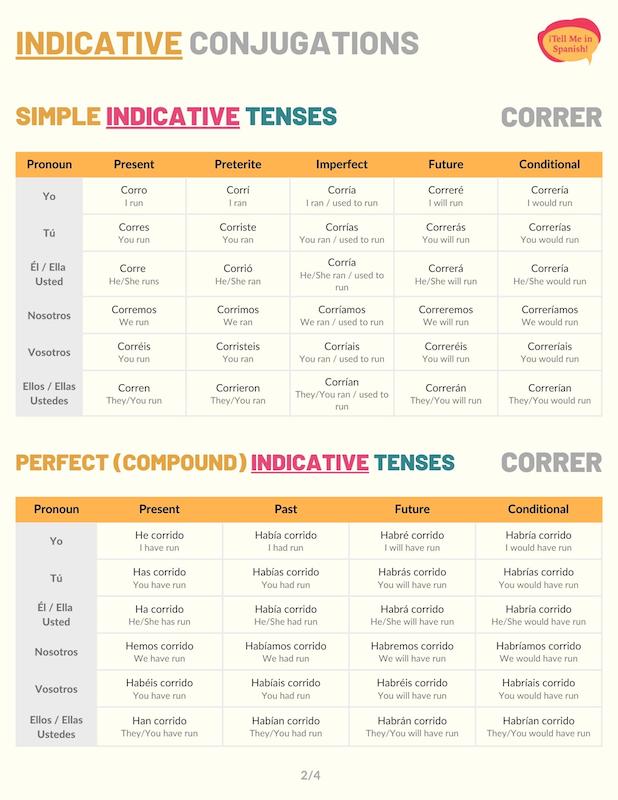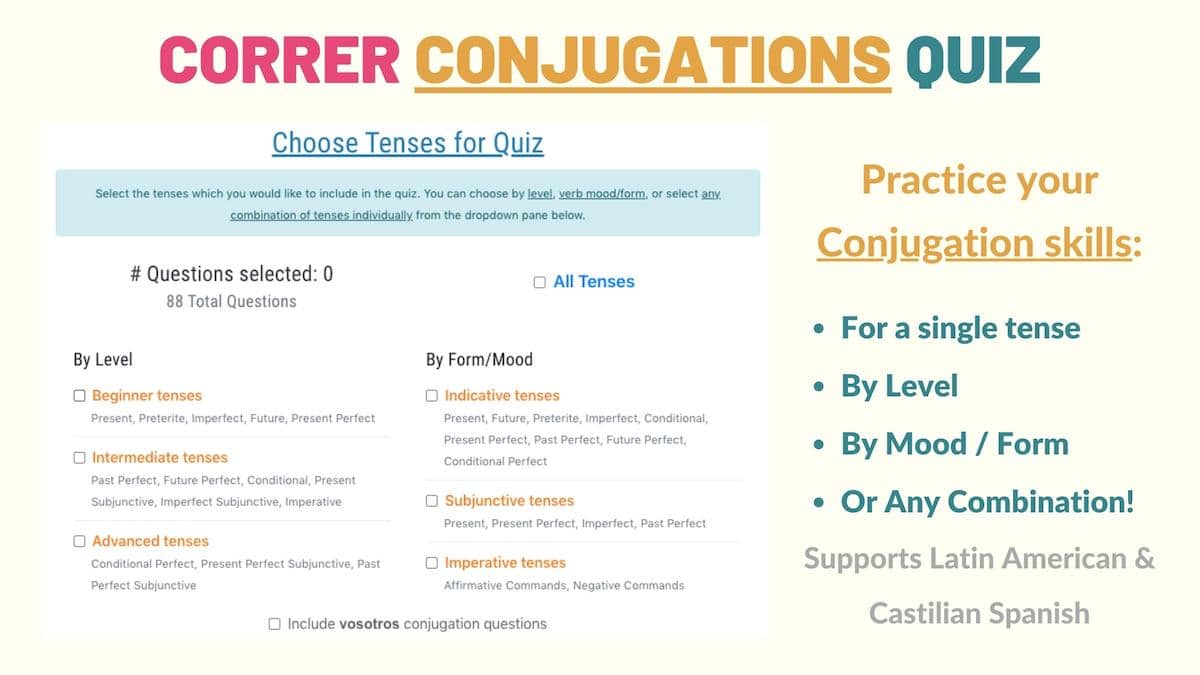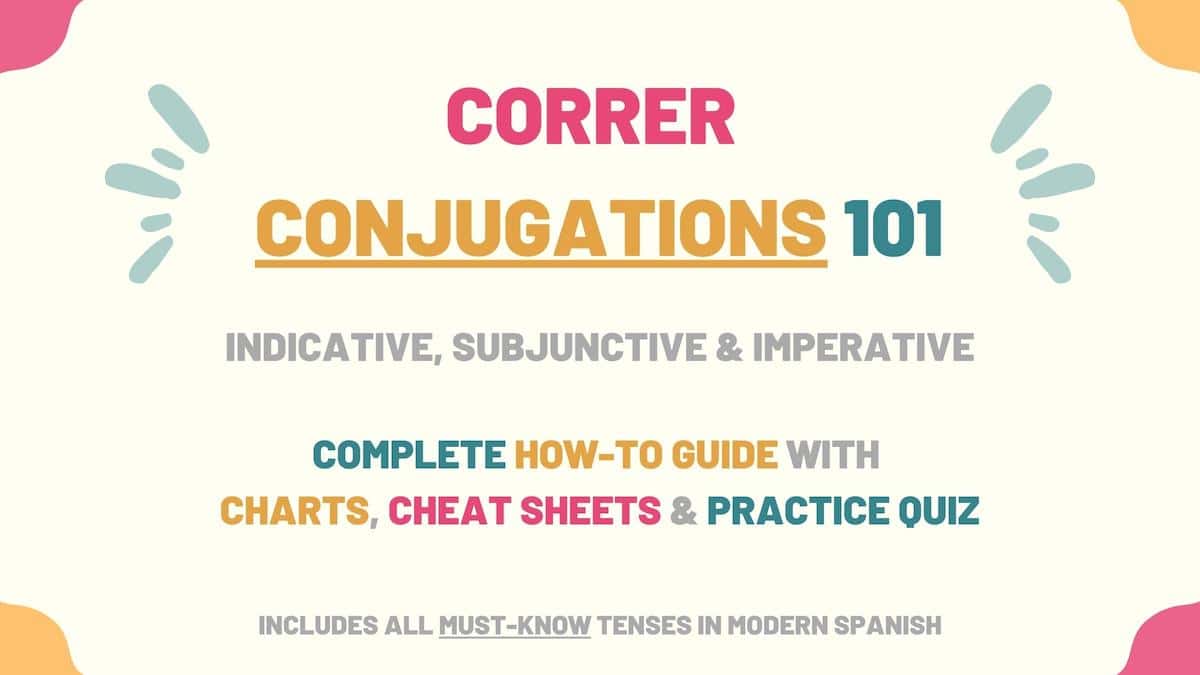Correr is one of the most common -ER verbs. Since it can help you practice and learn this conjugation group, in this guide, you’ll learn how to conjugate correr. Here is an overview of all the conjugation charts and additional resources we’ll cover:
- Correr Overview
- Indicative Tenses of Correr Conjugations
- Subjunctive Tenses of Correr Conjugations
- Imperative (Commands) of Correr Conjugations
- Uses & Examples
- Download Correr Conjugation Tables & Uses Cheat sheets
- Correr Conjugation Practice Quiz
Overview of Correr
| Verb Characteristic | Property |
|---|---|
| Verb Type | -ER |
| Irregular | No |
| Infinitive | Correr |
| Gerund (Present Participle) Form | Corriendo |
| Past Participle Form | Corrido |
| Synonyms | Despedir, trotar, pasar |
Depending on the sentence, correr can be translated as ‘to run’, ‘to fire’, or ‘to pass by’. For simplicity, I’ll only use one of these translations in the conjugation examples included in the tables below. You can check when to apply the other meanings in the Uses & Examples section.
Indicative Conjugations of Correr
Present tense
The present tense conjugation of correr allows you to talk about a person’s current running habits. For example: Simón corre todos los días.
| Person | Conjugation | Translation |
|---|---|---|
| Yo | Corro | I run |
| Tú | Corres | You run |
| Él / Ella Usted | Corre | He/She runs You (formal) run |
| Nosotros | Corremos | We run |
| Vosotros | Corréis | You run |
| Ellos / Ellas Ustedes | Corren | They run You (plural) run |
Preterite tense
Correr’s preterite conjugations can be used to communicate that someone ran or was fired at a specific time in the past. For instance, ayer corrí tres kilómetros. Below is the preterite conjugation chart for ‘correr’.
| Person | Conjugation | Translation |
|---|---|---|
| Yo | Corrí | I ran |
| Tú | Corriste | You ran |
| Él / Ella Usted | Corrió | He/She ran You (formal) ran |
| Nosotros | Corrimos | We ran |
| Vosotros | Corristeis | You ran |
| Ellos / Ellas Ustedes | Corrieron | They ran You (plural) ran |
Imperfect tense
The imperfect past tense of correr can be used to describe someone’s past running habits. Claudia y Tom corrían todas las tardes. Depending on the sentence, the imperfect conjugations of correr mean ‘used to run’ or ‘ran’.
| Person | Conjugation | Translation |
|---|---|---|
| Yo | Corría | I ran I used to run |
| Tú | Corrías | You ran You used to run |
| Él / Ella Usted | Corría | He/She ran He/She used to run You (formal) ran You (formal) used to run |
| Nosotros | Corríamos | We ran We used to run |
| Vosotros | Corríais | You ran You used to run |
| Ellos / Ellas Ustedes | Corrían | They ran They used to run You (plural) ran You (plural) used to run |
Near future
Ir (present) + a + correr is the structure to form the near future of ‘correr’ in Spanish. This form of ‘correr’ is used to express that someone will run or be fired in the immediate future. For instance: creo que van a correr a tres personas.
| Person | Conjugation | Translation |
|---|---|---|
| Yo | Voy a correr | I’m going to run |
| Tú | Vas a correr | You’re going to run |
| Él / Ella Usted | Va a correr | He/She is going to run You (formal) are going to run |
| Nosotros | Vamos a correr | We’re going to run |
| Vosotros | Vais a correr | You’re going to run |
| Ellos / Ellas Ustedes | Van a correr | They’re going to run You (plural) are going to run |
Future simple tense
Correr in the future tense is used to express that someone will run or be fired at some moment in the future. Mañana correré dos kilómetros más.
| Person | Conjugation | Translation |
|---|---|---|
| Yo | Correré | I will run |
| Tú | Correrás | You will run |
| Él / Ella Usted | Correrá | He/She will run You (formal) will run |
| Nosotros | Correremos | We will run |
| Vosotros | Correréis | You (formal) will run |
| Ellos / Ellas Ustedes | Correrán | They will run You (plural) will run |
Conditional tense
In the conditional tense, ‘correr’ communicates that someone would run if certain circumstances are met. For instance: si no estuviera lastimada, correría otra vuelta.
| Person | Conjugation | Translation |
|---|---|---|
| Yo | Correría | I would run |
| Tú | Correrías | You would run |
| Él / Ella Usted | Correría | He/She would run You (formal) would run |
| Nosotros | Correríamos | We would run |
| Vosotros | Correríais | You would run |
| Ellos / Ellas Ustedes | Correrían | They would run You (plural) would run |
Present perfect tense
In Spanish, the present perfect tense of ‘correr’ is used to talk about someone’s running activities in a moment close to the present. For example: esta semana no he corrido. This tense is formed with the structure ‘haber’ in the present tense + corrido.
| Person | Conjugation | Translation |
|---|---|---|
| Yo | He corrido | I have run |
| Tú | Has corrido | You have run |
| Él / Ella Usted | Ha corrido | He/She has run You (formal) have run |
| Nosotros | Hemos corrido | We have run |
| Vosotros | Habéis corrido | You have run |
| Ellos / Ellas Ustedes | Han corrido | They have run You (plural) have run |
Past perfect
The past perfect of ‘correr’ allows you to explain that someone ran or was fired before some other reference point in the past. No había corrido desde hace años. To form the past perfect, use the imperfect form of ‘haber’ and the past participle form of ‘correr’.
| Person | Conjugation | Translation |
|---|---|---|
| Yo | Había corrido | I had run |
| Tú | Habías corrido | You had run |
| Él / Ella Usted | Había corrido | He/She had run You (formal) had run |
| Nosotros | Habíamos corrido | We had run |
| Vosotros | Habíais corrido | You had run |
| Ellos / Ellas Ustedes | Habían corrido | They had run You (plural) had run |
Future perfect
The future perfect of ‘correr’ expresses that someone will run or be fired by or before a certain time in the future. For instance: para el lunes, habremos corrido diez kilómetros.
| Person | Conjugation | Translation |
|---|---|---|
| Yo | Habré corrido | I will have run |
| Tú | Habrás corrido | You will have run |
| Él / Ella Usted | Habrá corrido | He/She will have run You (formal) will have run |
| Nosotros | Habremos corrido | We will have run |
| Vosotros | Habréis corrido | You will have run |
| Ellos / Ellas Ustedes | Habrán corrido | They will have run You (plural) will have run |
Conditional perfect
In Spanish, the conditional perfect forms of ‘correr’ can be used to communicate that someone would have run if a past condition had been met. For example: habríamos corrido más, pero teníamos que regresar a trabajar.
| Person | Conjugation | Translation |
|---|---|---|
| Yo | Habría corrido | I would have run |
| Tú | Habrías corrido | You would have run |
| Él / Ella Usted | Habría corrido | He/She would have run You (formal) would have run |
| Nosotros | Habríamos corrido | We would have run |
| Vosotros | Habríais corrido | You would have run |
| Ellos / Ellas Ustedes | Habrían corrido | They would have run You (plural) would have run |
Progressive tenses
The progressive tenses forms of ‘correr’ are used to express that someone is running at the moment of speaking. Adam está corriendo. These tenses are formed with the verb estar and correr’s gerund form.
| Progressive Tense | Formula | Translation Example |
|---|---|---|
| Present | Estar (present) + corriendo | I am running |
| Preterite | Estar (preterite) + corriendo | You were running |
| Imperfect | Estar (imperfect) + corriendo | He was running |
| Future | Estar (future) + corriendo | We will be running |
| Conditional | Estar (conditional) + corriendo | They would be running |
Correr Subjunctive Conjugations
In Spanish, the subjunctive is used to talk about wishes, hypothetical situations or express uncertainty. The conjugation charts below show the subjunctive forms of correr.
Present subjunctive
Correr’s subjunctive conjugations are regular. You can use the subjunctive forms of ‘correr’ to recommend someone to run or to provide them with suggestions about this activity. For example: es necesario que corras más rápido.
| Person | Conjugation | Translation |
|---|---|---|
| Yo | Corra | I run |
| Tú | Corras | You run |
| Él / Ella Usted | Corra | He/She runs You (formal) run |
| Nosotros | Corramos | We run |
| Vosotros | Corráis | You run |
| Ellos / Ellas Ustedes | Corran | They run You (plural) run |
Present perfect subjunctive
Haber in the present subjunctive + corrido is the formula to build the present perfect subjunctive of ‘correr’. With this tense, ‘correr’ conveys uncertainty about people being fired or their running activities. For instance: no creo que hayan corrido a nadie.
| Person | Conjugation | Translation |
|---|---|---|
| Yo | Haya corrido | I have run |
| Tú | Hayas corrido | You have run |
| Él / Ella Usted | Haya corrido | He/She has run You (formal) have run |
| Nosotros | Hayamos corrido | We have run |
| Vosotros | Hayáis corrido | You have run |
| Ellos / Ellas Ustedes | Hayan corrido | They have run You (plural) have run |
Imperfect subjunctive
You can use the imperfect subjunctive of ‘correr’ to talk about past suggestions, wishes, recommendations you made to someone about running. El doctor me dijo que corriera todos los días.
The imperfect subjunctive has two conjugation models depending on which type of Spanish you’re using:
Latin American Spanish version
| Person | Conjugation | Translation |
|---|---|---|
| Yo | Corriera | I ran |
| Tú | Corrieras | You ran |
| Él / Ella Usted | Corriera | He/She ran You (formal) ran |
| Nosotros | Corriéramos | We ran |
| Ellos / Ellas Ustedes | Corrieran | They ran You (plural) ran |
Note: The table above doesn’t include the conjugation for vosotros because this pronoun is not used in Latin American Spanish.
Castilian Spanish version
| Person | Conjugation | Translation |
|---|---|---|
| Yo | Corriese | I ran |
| Tú | Corrieses | You ran |
| Él / Ella Usted | Corriese | He/She ran You (formal) ran |
| Nosotros | Corriésemos | We ran |
| Vosotros | Corrieseis | You ran |
| Ellos / Ellas Ustedes | Corriesen | They ran You (plural) ran |
Past perfect subjunctive
In the past perfect subjunctive, correr communicates that someone would have run if a past circumstance was met. This tense can also be used to talk about wishes or express regret about running. For example: Ojalá hubiéramos corrido un poco más.
| Person | Conjugation | Translation |
|---|---|---|
| Yo | Hubiera corrido | I had run |
| Tú | Hubieras corrido | You had run |
| Él / Ella Usted | Hubiera corrido | He/She had run You (formal) had run |
| Nosotros | Hubiéramos corrido | We had run |
| Vosotros | Hubierais corrido | You had run |
| Ellos / Ellas Ustedes | Hubieran corrido | They had run You (plural) had run |
Correr Imperative Conjugations
The imperative is used to give commands in Spanish and tell people what to do (affirmative imperative) and what not to do (negative imperative).
Affirmative commands
You can use affirmative commands to order or recommend someone to run or fire another person. Si el sol te molesta, corre en las tardes.
| Person | Conjugation | Translation |
|---|---|---|
| Tú | Corre | Run |
| Usted | Corra | Run |
| Vosotros | Corred | Run |
| Ustedes | Corran | Run |
Negative commands
On the other hand, the negative imperative allows you to order someone to not run or fire another person. For example: no corras a Judith, no fue su culpa.
| Person | Conjugation | Translation |
|---|---|---|
| Tú | No corras | Don’t run |
| Usted | No corra | Don’t run |
| Vosotros | No corráis | Don’t run |
| Ustedes | No corran | Don’t run |
Correr Meanings & Examples
Since you already studied correr conjugation charts, below you can learn the most common applications of this verb.
1. As the equivalent of ‘to run’
[Correr conjugated] + [complement]
¿Hasta dónde corriste hoy, Oliver?
How far did you run today, Oliver?
El instructor nos pidió que corriéramos más rápido.
The coach asked us to run faster.
Take Note: In books or movies, the imperfect form of correr is used as a formal way to say a date in Spanish. Corría el año de 1950…(it was 1950).
2. Talk about firing people
La semana pasada corrieron a Mindy y Tyler.
Last week, Mindy and Tyler got fired.
¿Qué pasaría si la corrieras?
What would happen if you fired her?
Take Note: This meaning of ‘correr’ is more commonly used in Latin American Spanish. Note that in this context ‘correr’ works with a direct object, which means you can use direct object pronouns.
Download Correr Conjugation Tables & Uses Cheat sheets

I’ve created a downloadable PDF containing all of the conjugation tables, verb characteristics, and uses for correr so you can study it later!
Practice Quiz: Correr Conjugation

If you’re ready to practice your conjugation skills, then take the correr conjugation practice quiz!



